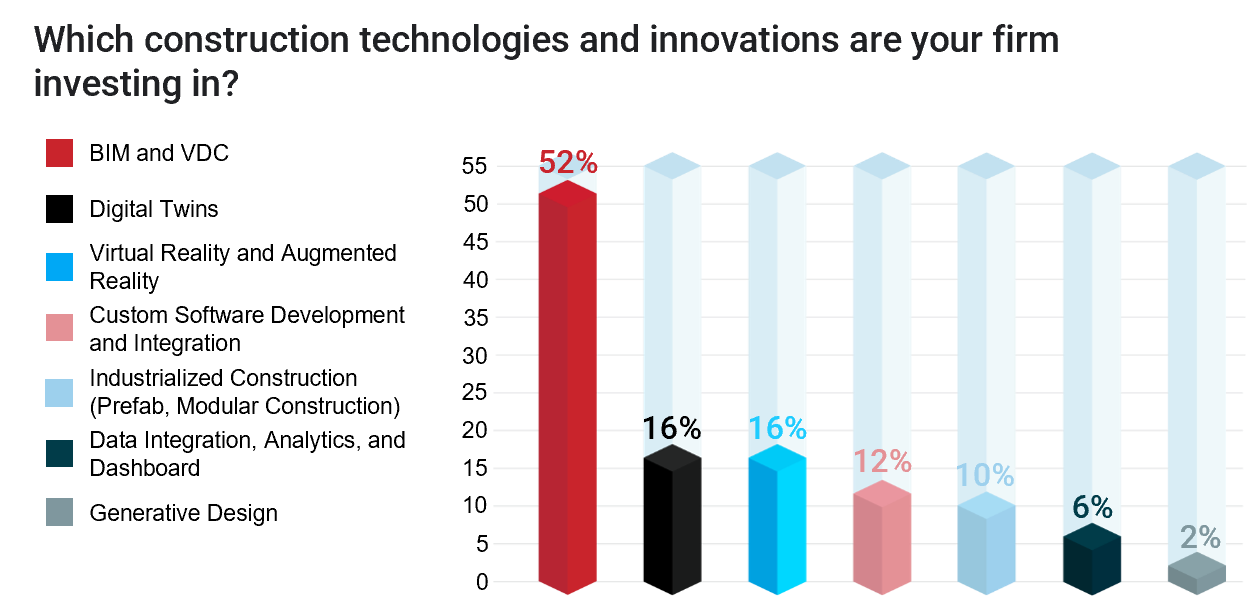“It's just more data.” … “More acronyms.” ... “More 3D and 4D and 5D or... who even knows?”
If that's someone's response when introduced to virtual design and construction (VDC), it might be time for them to take a step back and catch their breath.
VDC has been around since 2002, but it's still frequently misunderstood. Unfortunately, as we speak to stakeholders, many of them think of it as just another term for BIM or 3D modeling. Or they may see VDC as a loose set of aspirational goals. But equating either of these with VDC is like equating Excel with a financial plan. One is a tool; the other is the application of that tool. And far from a loose set of goals, adopting that tool demands dedication. It entails the creation and implementation of a well-defined, cohesive plan to drive successful organizational outcomes.
Do you need VDC?
In theory, when owners and general contractors are working within a predictable framework, VDC would not necessarily be needed. By a “predictable framework”, we mean:
- the owner has well-defined needs that are unlikely to change
- the general contractor has internalized knowledge due to repeatedly building the same thing with the same team, or
- the owner has experience working with not just the same company but also the same people on the same project type.
However, in reality, this perfect scenario almost never exists. This is why VDC is critically important to achieving results due to the variability, change, and complexity inherent to the construction industry. When the owner is working with complex stakeholders, or change is likely to occur in the late design stages, VDC can provide a framework to incorporate change while limiting disruption. Similarly, VDC can support team coordination when the individuals haven’t worked together in the past. And VDC can always be of benefit when transparency and accountability are desired.
Growing challenges in cost planning heighten VDC's importance
It's no secret that every industry has struggled with supply chain issues in recent years. Lumber is among the commodities whose prices have skyrocketed as a result. But the extreme nature of this recent surge may obscure the fact that the construction industry has always had to deal with volatile prices, more so than almost any other. Cost planning is also made more difficult by the growing number of complex projects worldwide.
How does VDC become part of the solution to the challenges of cost unpredictability? Through the integration of people, process, and technology, VDC allows construction teams to answer critical questions very early in a project and with a high level of certainty.
Challenges & Opportunities to Advancing VDC Maturity
The road to VDC maturity will no doubt be filled with challenges. But where there are challenges, there is opportunity for firms who can differentiate from the pack. VIATechnik recently conducted a survey on digital transformation across leading AEC firms. When asked which construction technologies or innovations their organization is investing in, BIM and VDC surfaced as the primary area of investment in over half of the respondents. The primary benefits of this investment included 1) reduced operating costs 2) improved client satisfaction 3) reduced development time for new products or service offerings 4) better talent recruitment and retention and 5) increased revenue.

How to unlock full VDC potential
The path to the pinnacle of VDC maturity covers a multi-stage ascent for a team, a project, and the company. But before taking even the first step on that journey to full VDC potential, an organization must prepare its culture. The onus is on senior leadership to take initiative in a three-phased approach:
- Phase I: Setting the foundation - Focus on alignment to the organization's business strategy
- Phase II: Break down VIATechnik’s VDC Maturity Curve in order to assess where a program is and where it can go
- Phase III: Support the VDC journey - Determine how VDC can be operationalized into the DNA of the project/real estate portfolio
To help organizations progress in their VDC journey, VIATechnik has created the VDC Maturity Curve.
What to expect from the study
Hundreds of hours of research and a deep dive into lessons learned on 2000+ projects have been distilled into actionable insights. Here’s what AEC leaders will get:
- Run through the 6 phases of VDC maturity, to understand how your organization measures up and how you can take VDC to the next level of value creation
- Understand what differentiates best-in-class VDC organizations from the pack
- Learn the value of VDC and how to unlock this value for your organization
- Get access to the VDC Champion Checklist, which provides a playbook for success
Download Getting to the Next Level in Project Planning: VIATechnik's VDC Maturity Curve to learn more.
More from Author
VIATechnik | Jul 17, 2023
Unlocking the power of digital twins: Maximizing success with OKRs
To effectively capitalize on digital twin technology, owners can align their efforts using objectives and key results (OKRs).
VIATechnik | Sep 28, 2021
Getting diversity, equity, and inclusion going in AEC firms
As a professional services organization built on attracting the best and brightest talent, VIATechnik relies on finding new ways to do just that. Here are some tips that we’ve learned through our diversity, equity, and inclusion (DE&I) journey.
VIATechnik | Mar 2, 2021
Retail expectations vs reality in 2021
The reality of retail success in 2021 is proving to be based on a formula of mixing digital with the physical in pursuit of convenience.
VIATechnik | Nov 23, 2020
Agility is the game-changer in the post-COVID world
There has been a fundamental shift in how human beings live, work, and play. The built environment must shift in response.
VIATechnik | Nov 17, 2020
The coming automation of retail brick and mortar
The demise of retail brick and mortar is overstated and unwarranted - we see digital transformation offering brick and mortar a path forward for the physical store.
VIATechnik | Oct 1, 2020
Smart buildings stand on good data
The coming disruption of owning and operating a building and how to stay ahead through BIM.
VIATechnik | Jul 15, 2020
Building pride: A Reflection of LGBTQ rights in construction
The Supreme Court did its job. The rest is up to us.
VIATechnik | May 8, 2020
Data centers as a service: The next big opportunity for design teams
As data centers compete to process more data with lower latency, the AEC industry is ideally positioned to develop design standards that ensure long-term flexibility.
VIATechnik | Mar 17, 2020
A tree grows in Stanford: CIFE, VDC, and where it all began
As our industry adopts VDC as standard practice, it is important to remember where these ideas began and continue to emanate from today.
VIATechnik | Mar 5, 2020
These 17 women are changing the face of construction
During this Women in Construction Week, we shine a spotlight on 17 female leaders in design, construction, and real estate to spur an important conversation of diversity, inclusion, and empowerment.















